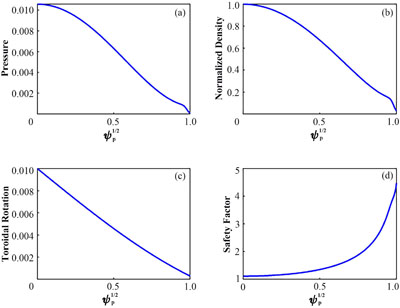Yihuizi LIU, Neng ZHANG, Yueqiang LIU, Xueyu GONG, Shuo WANG, Chunyu LI, Lian WANG, Guangzhou HAO. Influence of kinetic effects on plasma response to resonant magnetic perturbations in HL-2A tokamak[J]. NUCLEAR TECHNIQUES, 2024, 47(5): 050006
Search by keywords or author
- NUCLEAR TECHNIQUES
- Vol. 47, Issue 5, 050006 (2024)

Fig. 1. Radial profiles of the key equilibrium quantities for HL-2A discharge 36 872 at 1 240 ms (a) The plasma pressure normalized by

Fig. 2. The layout of the HL-2A plasma boundary and the position of the resonant magnetic perturbation coils (color online)
Fig. 3. The MARS-F computed
Fig. 4. The MARS-F computed amplitude of the resonant radial field perturbation
Fig. 5. Comparison of the poloidal spectra of the radial magnetic field perturbation computed with
Fig. 6. The computed poloidal distribution of the total response field (left panels) and the radial displacement of the plasma (right panels) caused by
Fig. 7. MARS-F/K computed the total response field (external + plasma response) for three models at different rotation frequencies, including (a) the radial profiles of the m/n=4/1 resonant component and (b) the maximum amplitude of the poloidal Fourier harmonics (along the minor radius)
Fig. 8. The MARS-F computed growth rate of no-wall ideal external kink instability with
Fig. 9. The MARS-F/K computed plasma radial displacement amplitude near the X-point while varying
Fig. 10. The MARS-K computed diagram of the relation between the plasma radial displacement amplitude near the X-point and
Fig. 11. The real and imaginary parts of the normalized perturbed kinetic energy
Fig. 12. Radial profiles illustrating various frequencies

Set citation alerts for the article
Please enter your email address



